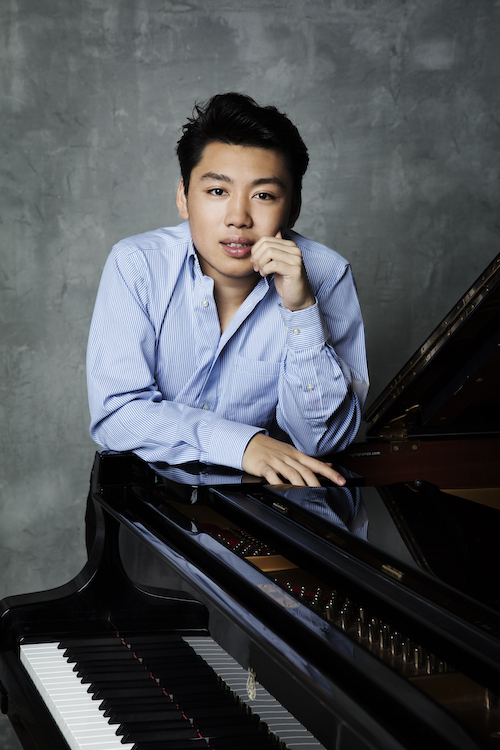George Li brings artistry and bracing bravura to Kravis recital

Pianist George Li performed Sunday afternoon at the Kravis Center in West Palm Beach. Photo: Simon Fowler
No one could say the young American pianist George Li doesn’t earn his pay. He responded to standing ovations Sunday afternoon at the Kravis Center with three encores, including one that must have been a workout for a pianist who had just played a full and demanding recital.
Li performed works of 19th century German romanticism and the early 20th century Parisian avant-garde—plus encores that spanned 200 years of music—two days after playing the same program at Carnegie Hall.
At 27, Li is still in school, pursuing an artist’s diploma at the New England Conservatory in Boston. But he has a full concert schedule, with recitals and concerto performances with major orchestras. He has won major international awards, including the silver medal in the 2015 Tchaikovsky competition in Moscow. (Winning “only” second prize in the Tchaikovsky is no impediment to a major career, as Misha Dichter can attest.)
He opened with Schumann’s Arabesque, Op. 18, playing the concise work in a free but focused manner, stretching the rhythm to bring poetry and vulnerability to its melodies.
The big work in the first half was Schumann’s Davidsbündlertänze, a series of short movements inspired by the alternate sides of the composer’s personality—one side assertive and energetic, the other poetic and inward-looking. Li’s technique and musicality allowed him to express the contrasting sensibilities effectively, particularly his ability to play lightning-fast passages in an even and understated manner.
The pianist played the extroverted opening in a manner that was lively but never percussive, keeping holstered the bright tone he would deploy later in the recital for a work of Stravinsky. In the ninth section, which is full of the rumbling bass figures that are characteristic of Schumann’s piano music, Li played with a light, articulated touch that expressed their power without making them too thunderous.
Too much bass covered the melodic line in the opening of the fourth piece, but that’s a quibble in an otherwise fine performance. In the movement marked “From afar,” a melancholy melody from the second movement returns, and Li played in a manner that was full of wistfulness and nostalgia.
In Ravel’s Valses nobles et sentimentales he played in an impetuous, rhythmically free manner that still retained the ghost of a waltz in passages where that rhythm seemed to have disappeared. In the treble passages where much of the work is heard, Li brought shimmering colors to lush, impressionist harmonies that shocked 1911 Parisian listeners.
Piano arrangements of orchestral works can fall flat, since even 88 keys can’t compete with the richness of strings, flutes, horns and the rest. But Stravinsky himself did the piano arrangement of three movements of his 1911 ballet Petrushka, preparing the work for the renowned pianist Arthur Rubinstein in a manner that would take advantage of the instrument’s strengths.
In Li’s hands, Stravinsky’s arrangement of this Petrushka mini-suite came off as an engaging concert work that required formidable technique. In the “Russian Dance,” Li unleashed his virtuosity, pounding away in the opening melody in a manner that was bright but never harsh.
In “Petrushka’s Room,” the famous Petrushka chord, a discordant pair of triads, came off with surprisingly rich and full color that here didn’t lose anything from the orchestral version. Li surrounded the ensuing passage with a blur of harmonic figurations in an impressive display of virtuosity and the piano’s color palette. The concluding “Shrovetide Fair” was a dramatic and theatrical episode, with Li’s hands sweeping across the keyboard and darting from note to note with impressive accuracy and power.
The audience was enthusiastic, greeting one particularly virtuosic movement of the Schumann with a burst of applause and giving Li repeated standing ovations.
He responded with Gluck-Sgambati’s Melody from the opera Orfeo, playing in a restrained, classical manner that allowed the famous air’s pathos to come through. Li next served up Vladimir Horowitz’s Carmen Fantasy, a pastiche of the opera’s melodies, souped-up with 20th century harmonies and virtuoso fireworks that Li handled with accuracy and flamboyant style. His final encore was Chopin’s “Raindrop” Prelude, in which his performance brought out the work’s serenity yet with an underlying tension.
Saxophonist Steven Banks and pianist Xak Bjerken perform music of Bach, Saint-Saëns. Simon and Rachmaninoff 7:30 p.m. Wednesday at the Kravis Center’s Rinker Playhouse. kravis.org
Posted in Performances
One Response to “George Li brings artistry and bracing bravura to Kravis recital”
Leave a Comment
Mon Dec 12, 2022
at 11:23 am
1 Comment
Posted Dec 17, 2022 at 2:05 pm by Sue Cassidy Clark
I’ve been following George Li’s career for seven years now since I first heard him play, Prokofiev’s First Piano Concerto @ BAM in Brooklyn New York City with the Mariinsky Orchestra under Maestro Gergiev! I heard him next perform the recital at Hunter College Playhouse. Also, more recently at Carnegie Hall’s Weill Recital Hall and last week at Carnegie Hall Zankel Hall. I have both his released records, and find him to be outstanding and agreed with your review of his concert.
He is a very special artist!!